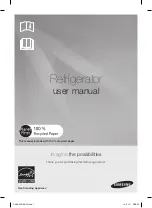
Whirlpool of India
260 L DC CFC FREE
This document is only intended for qualified technicians who are aware of the respective safety regulations.
First Released Date 17
TH
July, 2002
Subject to modification
Document No. WOI/DC/2002/07
PAGE 21 of 21
(B) Check for Customer Usage
?
Frequent / prolonged door opening
?
Door not closed properly
?
Hot food kept inside
?
Polythene cover spread on shelves
?
Improper loading
?
Defrosting not done regularly
?
Incorrect Thermostat setting
?
Liquid items kept uncovered
?
Condenser / walls covered by Refrigerator Cover
(C) Check for Mechanical problems
?
Poor Door gasket sealing.
?
Components making vibrations/noise (Condenser clamps etc).
?
Improper Compressor mounting.
?
Vibrating Defrost water tray.
?
Condenser tubes touching each other.
?
Noisy Compressor.
?
Door opening noise (door hinge to be oiled).
(D) Check for Electrical problems
?
Defective power cord / cabinet wiring
?
Loose wire connector
?
Loose / defective Thermostat terminals
?
Loose / defective Relay / OLP
?
Open / short / jam Compressor
(A) Check for proper Installation
?
Check for proper leveling. Front legs should be slightly higher than the rear legs. To check leveling, release the
door from an angle less than 45°, it should close gently.
?
Clearance between backside & Wall should be min. 6” & clearance between Topside & Wall should be min. 12”.
This is required for dispersion of heat.
?
Earthing of Electrical point.
?
Extension cords should be avoided.
?
Earthing pin is not removed. If a separate fuse circuit is used, its rating should be 15 amperes.
?
Door sealing should be proper.
?
Refrigerator is placed away from direct sunlight and other high temperature sources like gas cylinders, ovens and
cooking ranges.
GENERAL INSTRUCTIONS FOR SERVICE ENGINEERS

































